A tile laying, area control game for 1-5 players
30-60 minutes
Designed by: Xavier Georges
Published by: Pearl Games
Growing up in the US Midwest, we both have vivid memories of hiking and camping. To this day, the smell of a pine forest is enough to send us back to memories of hiking, fishing, or camping. While neither of us would today identify as “outdoorsy” (does a hotel next to a city park count as glamping?) our appreciation for the great Midwestern wilderness never left us.

And that brings us to Ginkgopolis, a game (loosely) about living symbiotically with Ginkgo Biloba trees. While there aren’t many (any?) Ginkgo Biloba trees in Minnesota or Michigan, we can relate to wanting to live in greater harmony with nature. Released in 2012, Ginkgopolis is a response to the growing concern of the human threat to the environment. Set in a future where humans have exhausted all other resources, they must build cities relying on the oldest and heartiest of trees – the Ginkgo Biloba. This time around humans do it right and strive for a mutually beneficial relationship with nature.
While the theme isn’t so much an immersive “theme” as it is an excuse for pretty artwork featuring aesthetically pleasing futurism, you’ll hear few complaints from us. The game play is dynamic, unique, and just plain fun. It’s well worth struggling through the high barrier to entry, since we’re certain you don’t have another game exactly like this one on your shelf.
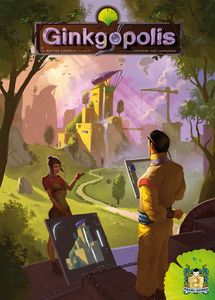
Gameplay Overview
*Note: this is a general overview, not a detailed how-to-play description and will not include every rule
Ginkgopolis was first released in 2012, with a modular expansion released the following year. While we enjoy the expansions, we will focus this review only on the base game. (Drop a comment below or send a message if you want to hear more about the expansion).
The game begins with the 9 starting tiles (3 of each color, more on color significance below) laid out in a 3 x 3 grid surrounded by the 12 urbanization tiles A-L in alphabetical order. Players start by gaining 3 character cards that give them their starting items and permanent action bonuses. They can obtain character cards optionally by dealing them out (boring) or drafting (fun!).
Before we get to a more detailed explanation, it’s important to note that there are 3 types of items in Ginkgopolis, each associated with a color:
- Red – resources
- Blue – tiles
- Yellow – success points (VPs)
Ginkgopolis is a melting pot of several different types of games with a lot of mechanics cobbled together in a way that shouldn’t work but totally does. We’ve stated here that it’s a tile placement/area control game – and it is! – but it also has a card drafting mechanism similar to games like 7 Wonders that is critical to consider for a winning strategy.
The game is essentially a series of rounds broken up only by replenishing the draw deck (which we’ll get to below). Each round has the following structure:
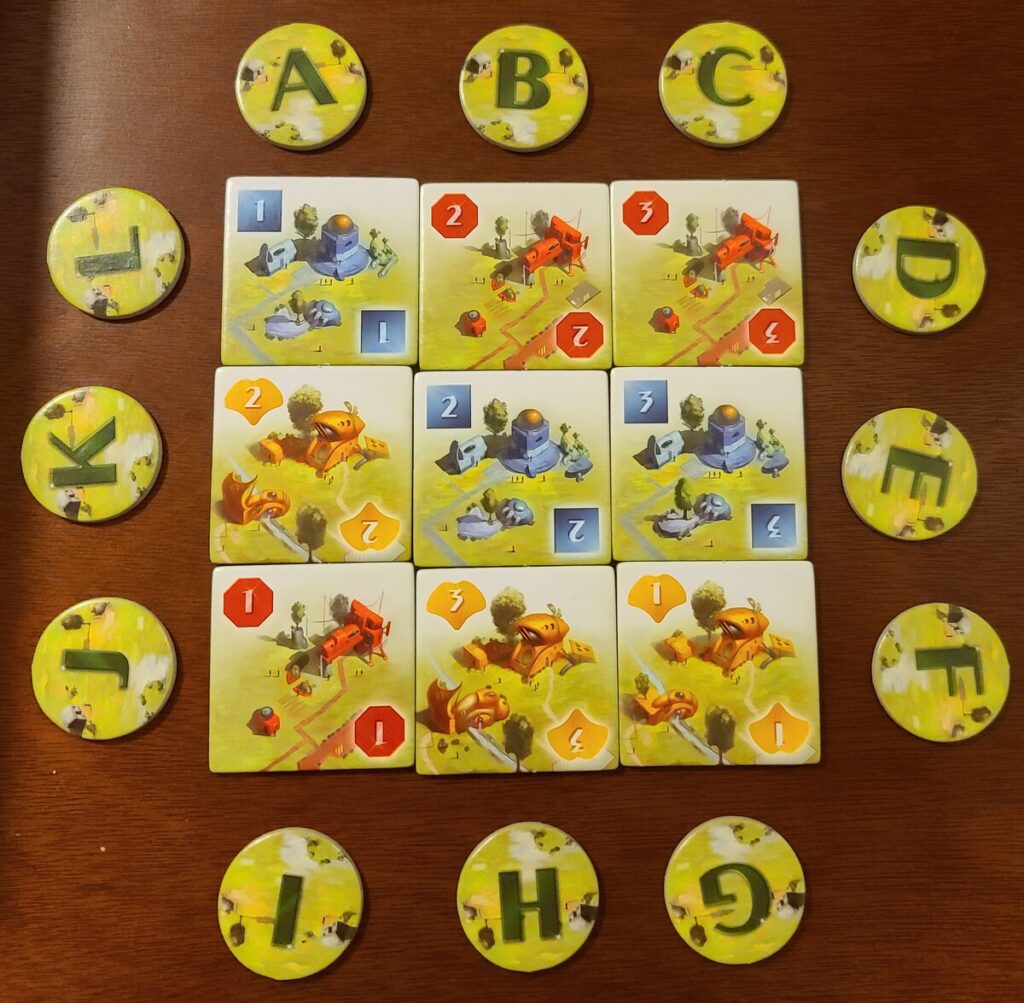
1. Players draw a card (in turn order) so their hand has 4 cards
In the first round of the game, players draw 4 cards to start their hand. In subsequent rounds, they’ll have a hand of 3 and need to draw up to 4. Players will never need to draw more than 1 card, and will never have a hand larger than 4 cards.
2. All players simultaneously choose a card from their hand and lay it face-down on the table
At any time, players may use a hand token (2 total per player) to put their hand of cards in the discard pile and draw a new hand before selecting a card
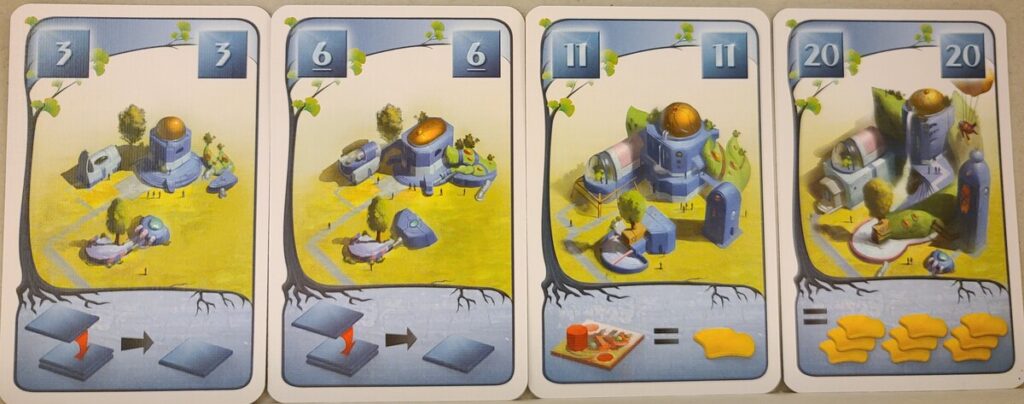
3. Resolve actions in turn order
There are several different types of actions. Since each player can only choose 1 card on their turn, they will only ever do 1 action at a time.
Here are the action options:
Option 1: Exploit a card: Play a card to get items (resources, tiles, points)
- Play ONE of the following card types:
- Building cards: play a numbered card to get the item associated with the color of the building. Number of items taken is dependent on the level of the associated numbered tile (that is, a stack of 2 tiles = 2 items)
- Urbanization (letter) cards: play a letter (A-L) card and take a single resource or tile
- Take bonuses based on permanent bonuses in your tableau, if applicable
- Discard the card in the central discard pile
Option 2: Urbanize: Play a letter card (A-L) with a tile and a resource token to build outwards
- Place a tile from behind your screen at the location of the letter token matching the letter of the played card
- Place your resource token on the new tile
- Place gray construction pawn on new tile
- Move urbanization letter token to new location adjacent to the new tile
- Gain items based on buildings orthogonally (not diagonally) adjacent to the newly placed tile (example, if you placed next to a 2-level blue stack, gain 2 tiles)
- Take urbanization bonuses based on your player card tableau, if applicable
- Return the played card to discard pile
Pro Tip: It’s super easy to forget to take all of your items, especially later in the game. When urbanizing, always check the adjacent tiles and your card tableau to make sure you don’t miss out on collecting your bonuses!
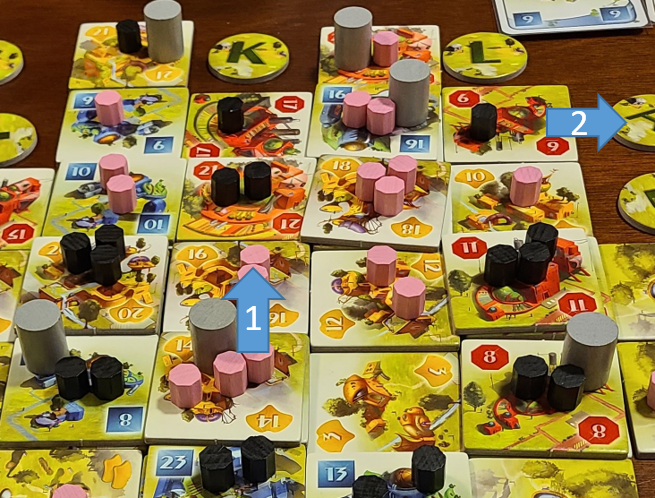
Option 3: Construct (aka overbuild or stack): Play a numbered building card with a tile and the required number of resource tokens
- Build (place a new tile from behind your screen) on top of tile with the same number and color as the played card
- If new tile is a lower number than the tile being overbuilt, pay the difference in VPs
- If the new tile is a different color than the tile being overbuilt, pay an additional resource token
- Place a gray construction pawn on new tile
- If another player had resources on the tile that was built over, return their resources behind their screen
- Opponents get 1 VP per resource returned
- Place resources of associated level on new tile (level 1 building, 2 resources)
- Take bonuses from cards already in their tableau, if applicable
- Keep played card in front of you for permanent action bonuses or end-game scoring
Pro Tip: The player at the end of the game with the most resources on a large area of a single color scores a ton of points. Use construct to change the colors of tiles in their controlled districts. Even if it doesn’t particularly benefit you, it sure can hurt their final score! This is a super fun way to make an enemy of your family and friends.
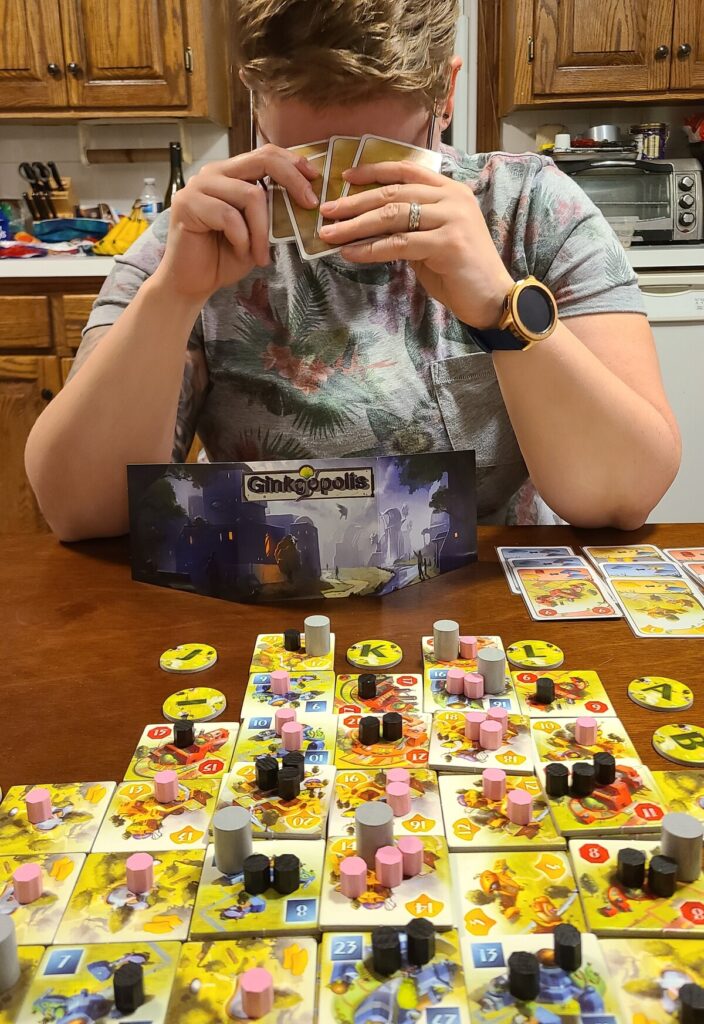
4. Prepare for Next Turn - Pass hand and the 1st player card to the left
5. Check for end game conditions
- Tile draw pile runs out
- The first time the tile pile runs out, players secretly add a number of tiles from behind their player shields back into the draw pile
- Gain 1 VP for each returned tile
- Continue playing until the tiles run out a second time, then the game ends
- The first time the tile pile runs out, players secretly add a number of tiles from behind their player shields back into the draw pile
- A player has all their resources on the map
IMPORTANT RULE: If the draw deck is exhausted, IMMEDIATELY pause whatever you’re doing and do the following actions:
- Add in cards corresponding to the newly played tiles that have grey markers on them (see below), removing the markers as you go
- Reshuffle deck including all newly added cards
- In a 2-player game, discard the top 7 cards before proceeding
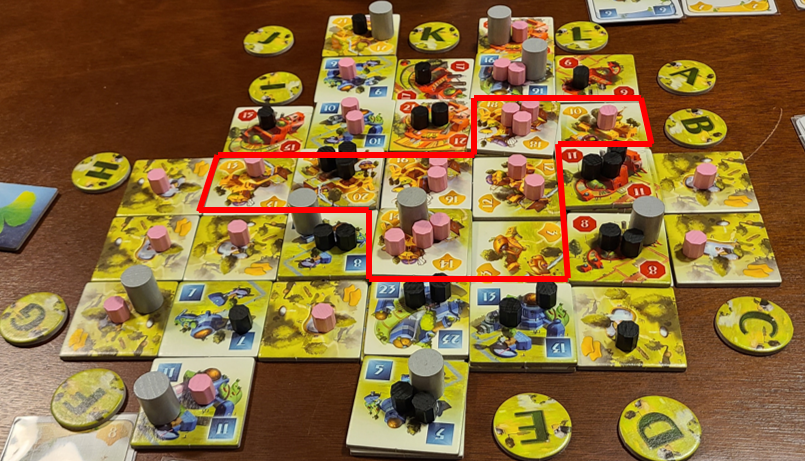
End Game Scoring
End game scoring awards points for control of each district of the map, VPs earned during the game, end game card bonuses, and unused hand tokens.
What do we think?
Ginkgopolis is an extremely abstract game, seemingly made up of many mini-mechanisms: tile placement, area control, card drafting, tableau building, and spatial planning. Trying to describe this game is like the story of people wearing blindfolds trying to describe all the different parts of an elephant. They’re all correct, but they’re all part of the bigger picture.
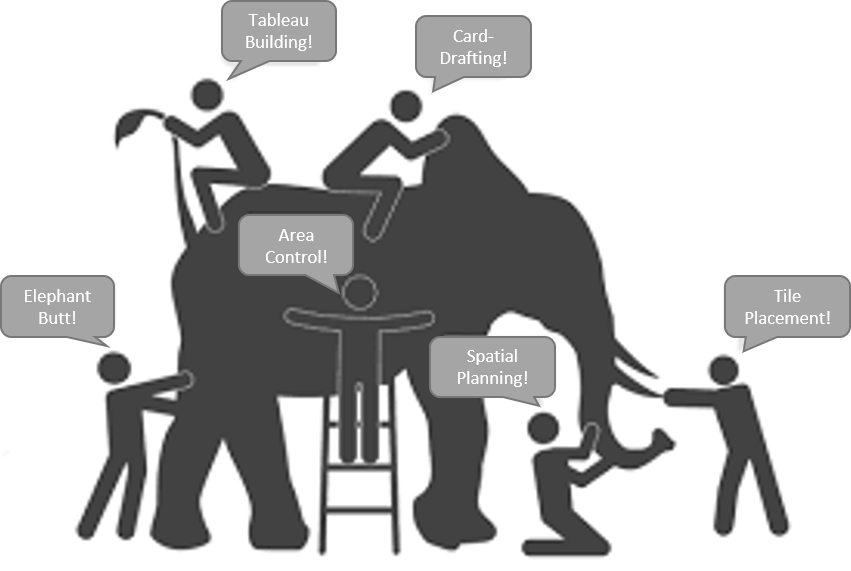
Ginkgopolis has a lot going on! It has the potential to cause a decent amount of analysis paralysis (AP) if given the opportunity. Especially late in the game, there is a lot of weighing decisions and mentally adding up how many points you could get from each turn and how you can best stop your opponents from getting points.
It’s also a very interactive game. You will be building over your opponents’ buildings. They will build on top of yours. You get a couple points when that happens, but it’s usually not enough to stop you from feeling saltier than the Dead Sea.
We don’t often like games with direct conflict as a core mechanism, but in Ginkgopolis we live for destroying each other’s large districts. It’s like playing chicken by building up larger areas and taunting the other players to destroy them, meets a battle of the wits on who’s played well enough to keep their areas intact and take over others.
Fun story about how we came to be in possession of Ginkgopolis:
When we got into board games Ginkgopolis had been out for a year or two and had some buzz, but not tons. Copies were still readily available from German and French retailers. But did we buy it then? Nope!
We had pretty much written Ginkgopolis off after playing some other tile laying and area control games and finding none of them really drew us in. Plus, Sarah is horrific with anything remotely resembling a spatial game, so off the wishlist Ginkgopolis went. And then it sold out everywhere and suddenly we had to have it. Like our 3-year-old when he really doesn’t want those last few strawberries on his plate until after mommy ate them (sorry bud, if you give me your food I’ll probably eat it).
FOMO is real.
Flash forward to August 2019 and we were at BGG@Sea and Ginkgopolis was there. Knowing it was out of print, we figured this would be our only opportunity to try it. So we did the socially awkward thing (to us! Sarah is a big introvert) and asked if we could join in a game. We were both instantly captivated and we knew right then that we would need to track down a copy. After several failed attempts to purchase on the after-market, we finally got ahold of a copy for juuuuust a bit too much money. And then the reprint was announced. Oh well, you win some you lose some.
Sarah's Take
I love Ginkgopolis and writing this review is strongly making me reconsider if it should actually be my #1 game (currently ranked #2). Nothing about the game should work for me.
I didn’t think I liked tile laying games. I didn’t think I like abstract-esque games. I didn’t think there could really be an area control game that played two players. And I certainly didn’t think I liked anything to do with city building because I am bad at visually planning it.
But Ginkgopolis works. The tableau is so satisfying to get a bunch of bonuses when you do something. The interaction, not something super common in euros that play well at two, is amazing.
It’s a really awkward and difficult game to describe or teach to others though. We are really bad at teaching and we had the most wonderful rules blunder in teaching Ginkgopolis a few months ago. We now ask our friends to watch a video before game nights to avoid that embarrassing mishap.
Emily's Take
Ok, so I did NOT expect Sarah to like this game as much as I do. Typically when we play games with heavy spatial mechanics (i.e. the location of your placement is important) I crush Sarah and she never wants to play again.
To my delight, this is the one spatial game where we tend to be evenly matched, which makes it a lot more fun (no offense, Sarah, remember how I can’t win Brass), and where both of us really like it.
The biggest drawback is the barrier to entry. The rules aren’t terrible to learn compared to other games in this weight class, but getting any sort of reasonable handle on strategy definitely takes a few games, especially against experienced players. It’s more nuanced than it seems at first glance, which makes it hard to calculate which moves are going to be effective in the long run.
I also love that it seems to scale pretty well. The game is SUPER fun at 2, and still holds up at 4, though it’s much slower.
First Play
We were taught to play our first Ginkgopolis. It was a 4 player game with all of us being new to the game. It can be a real tricky game to wrap your brain around so it definitely felt like it took until end game scoring to really understand how everything came together. Once we finished the first game we knew we wanted to play again and soon!
That said, this clearly has a very high barrier to entry. It’s tough to learn in a way that you’ll be able to “get it” on your first or even second play. We knew we loved it the first time, but we might just be weird since others we’ve introduced it to have taken a few plays to start liking it as well.
Rulebook
We did not learn the game from the rulebook so we can’t speak to learning from the rulebook. When we re-taught ourselves after finally buying the game, it wasn’t difficult to skim the rules for a refresher.
We also leveraged THIS awesome player aide. It worked for us as a reminder, and we still usually set it within reach when we go too long between plays.
Subsequent Plays
Ginkgopolis is a game that gets better with every play. The first play is really just a game of understanding how all the mechanisms mesh together and how scoring works. Experienced players will always have an advantage over newbies in that they will already know what each action does; as a new player this can take many turns to fully wrap your head around.
PSA: It’s worthwhile mentioning the general gaming etiquette: if you’re teaching this to your friends, go easy and don’t crush them the first time. Even if it’s sooooooooo tempting. This game is usually very easy to obliterate the newbies.
Play Time, Best Number of Players
We have played Ginkgopolis at player counts of 2, 3, and 4. As with most games we cover, Ginkgopolis plays great at 2. It’s actually probably best at 2 as it can be played pretty quickly for a heavy-ish game. If you’re looking for a game that is heavy and excellent at 2, this is definitely a go-to.
Ginkgopolis is one of those games that plays fast, but at higher play counts you don’t really feel like you have enough time to do everything you want to do. Playtime listed on the box, 45 minutes, is pretty accurate for fewer players, but it can drag out at higher player counts.
Parent Perspective
Ginkgopolis at 2-player is quick and is a great weeknight game for after the kids go to bed. If you have a clear plan in mind and can visualize what you want to do, then it is fairly accepting of interruptions, especially once you’re familiar with the game.
Another fun fact: Emily went into labor with Sullivan while we were playing Ginkgopolis during a date night (pre-COVID) at Fantasy Flight Game Center. She wasn’t convinced she was in labor (FYI early labor is kinda hard to distinguish from all the general discomfort near the end) so we finished the game (Emily won) and hung around to play some roll and writes until Sarah got waaaaay too anxious that we weren’t ready if the baby came that night. (Sarah’s note: we legit were not ready. We went home and I did 3 loads of laundry, packed the hospital bags, had to find the carseat buried in the garage, and then install it in the car). By about 3am Emily accepted she was in labor and we went to the hospital. Sullivan made his appearance at 1:34 pm that afternoon.
Rating
10/10: Excellent
Despite our few minor complaints about the barrier to entry, this is a game that we will always come back to for years to come. Ginkgopolis probably doesn’t get the kudos it deserves (outside of some gaming niches), or at least until it went out of print. The weak theme isn’t relevant when the artwork is ON POINT, the gameplay is highly unique, and the fun factor is off the charts.
*See our rating scale HERE
Click through for more posts, or follow us to see what we’re playing and for new post updates!
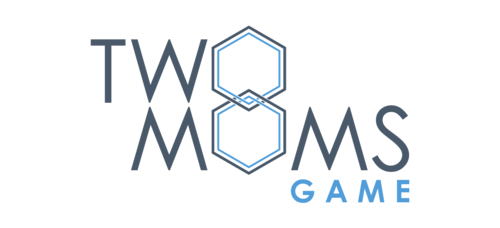
Your review is very convincing. I have to put this on our wishlist and keep an eye out for when the reprint is available.
We actually planted a ginkgo in our backyard a few years ago (here in South Dakota), but unfortunately it didn’t survive. We might try again in the front yard because they are such great looking trees!
Thanks! We hope it’s soon and gets plenty of hype! Actually getting ahold of the game right now is more of a barrier to entry than the challenging mechanics, but a reprint should help that significantly 🙂
We also looked up whether we could plant a ginkgo too while writing this review since we’ll have to cut down one of our big trees soon 🙁 Looks like it should be fine here in Minnesota (not too different from South Dakota?), super pest resistant and hearty in all sorts of weather too!